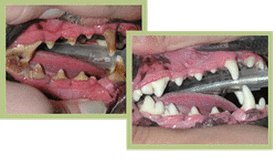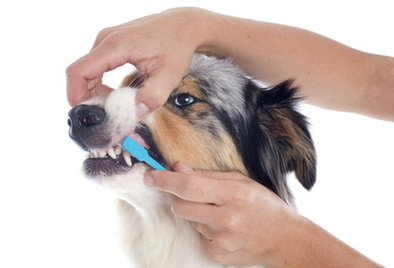Dental Care
Why Dental Care Is Important?
Proper dental care is important in keeping your pet healthy and happy. When your pet's teeth aren't clean, bad breath is not the only problem that your cat or dog faces. Periodontal disease, caused by a build-up of bacteria and plaque on your pet's teeth and gums causes bleeding and severe inflammation of the gums, gum recession, alveolar bone loss (the bone that supports the tooth is "eaten away") and tooth mobility. As periodontal disease progresses, the bacteria can spread from the mouth, travel through the blood and cause damage to the heart, liver and kidneys. Periodontal disease is not only serious, it is also more common than most pet owners realize. In fact, more than 80 percent of dogs and cats have this problem by the time they're four years old. So, it's easy to understand why periodontal disease is one of the most frequently diagnosed health problems in pets today. To help prevent periodontal disease in your pet, it's recommended to have your pets' teeth examined every 6 to 12 months.
Proper dental care is important in keeping your pet healthy and happy. When your pet's teeth aren't clean, bad breath is not the only problem that your cat or dog faces. Periodontal disease, caused by a build-up of bacteria and plaque on your pet's teeth and gums causes bleeding and severe inflammation of the gums, gum recession, alveolar bone loss (the bone that supports the tooth is "eaten away") and tooth mobility. As periodontal disease progresses, the bacteria can spread from the mouth, travel through the blood and cause damage to the heart, liver and kidneys. Periodontal disease is not only serious, it is also more common than most pet owners realize. In fact, more than 80 percent of dogs and cats have this problem by the time they're four years old. So, it's easy to understand why periodontal disease is one of the most frequently diagnosed health problems in pets today. To help prevent periodontal disease in your pet, it's recommended to have your pets' teeth examined every 6 to 12 months.
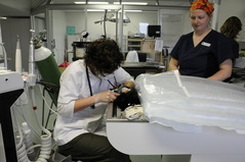
A professional dental cleaning is the safest, most effective way to remove plaque and tartar from your pet’s teeth and reduce the risk of periodontal disease. Veterinary dentistry is quite different from the equivalent process in people. For most of us, caring for our teeth and gums at home has been part of our daily routine for as long as we can remember. Consequently, a person's visit to the dental hygienist is relatively brief and does not require sedation. In contrast, veterinary dentistry is considerably more involved, time-consuming, and complex. Very few animals will willingly stay still enough (or open wide enough) for us to clean and polish their teeth, so a dentistry for your dog or cat will always involve a general anesthetic and consequently a day's hospitalization and the skills of several people, from veterinarians to veterinary technicians and animal attendants.
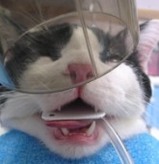 Performing Dental X-rays
Performing Dental X-rays
What Happens During a Dental Procedure
Because anesthesia is required to keep your pet safe and still during the cleaning, we perform a physical exam and a series of blood tests to ensure that your pet is healthy enough for this procedure. These tests also help us develop an anesthetic protocol that is specific for your pet. The first step is to visualize the mouth and teeth for any abnormalities. This is called dental charting. Charting begins with evaluation of the mouth for presence of plaque and calculus on the teeth. Next, the mouth is examined for missing teeth. Enamel and dentin fractures are then noted, including pulpal exposure if present. A periodontal probe with millimeter gradations is inserted between the free gingiva and tooth surface. The probe is gently advanced to the bottom of the periodontal pocket and walked along the entire wall of the tooth. The attachment loss and probe depths are noted on the chart we begin by removing tartar from the teeth using a hand scaler. A periodontal probe is then used to check for pockets under the gumline where periodontal disease and bad breath start. Next, an ultrasonic scaler is used to clean above the gumline and a curette is used to clean and smooth the teeth under the gumline. Your pet’s teeth are then polished, resulting in a smooth surface that is more resistant to plaque buildup. Finally, a fluoride treatment is used to help strengthen the enamel and reduce tooth sensitivity.
Because anesthesia is required to keep your pet safe and still during the cleaning, we perform a physical exam and a series of blood tests to ensure that your pet is healthy enough for this procedure. These tests also help us develop an anesthetic protocol that is specific for your pet. The first step is to visualize the mouth and teeth for any abnormalities. This is called dental charting. Charting begins with evaluation of the mouth for presence of plaque and calculus on the teeth. Next, the mouth is examined for missing teeth. Enamel and dentin fractures are then noted, including pulpal exposure if present. A periodontal probe with millimeter gradations is inserted between the free gingiva and tooth surface. The probe is gently advanced to the bottom of the periodontal pocket and walked along the entire wall of the tooth. The attachment loss and probe depths are noted on the chart we begin by removing tartar from the teeth using a hand scaler. A periodontal probe is then used to check for pockets under the gumline where periodontal disease and bad breath start. Next, an ultrasonic scaler is used to clean above the gumline and a curette is used to clean and smooth the teeth under the gumline. Your pet’s teeth are then polished, resulting in a smooth surface that is more resistant to plaque buildup. Finally, a fluoride treatment is used to help strengthen the enamel and reduce tooth sensitivity.
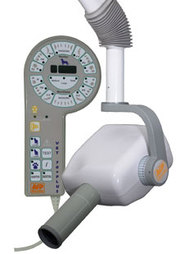
Dental Radiographs (X-rays) Intra-oral radiography is vital for assessment of dental health. If a problem is discovered on a post-cleaning examination of the mouth, suspicious areas are radiographed (x-rayed). Dental x-rays are necessary to help diagnose signs of tooth and bone disease and help the veterinarian decide if further treatment or extraction is indicated.
Dental Home Care
|
Brushing
Your veterinarian will often recommend brushing your pet's teeth. This may seem a little silly at first, but if you have the time and your pet is willing, this is a great way to give your pet healthy teeth and gums. Ask us about tooth paste and tooth brushes that would work for your pet. While it is impossible with brushing alone to remove tartar that has already formed, your efforts can slow or halt the formation of tartar, and gum health can be greatly improved. In a pet who has just had a dental prophylaxis (cleaning) brushing can go a long way towards preserving that new pearly white smile! Click on the following links for great tips on brushing your pets teeth. |
Special Food for Reduction of Tartar
There are now a number of foods on the market (found both at the veterinary hospital and at the pet store) which can help to minimize plaque and tartar buildup. These foods are appropriate if your pet does not like to chew enough to keep their teeth and gums healthy, or if you are unable to brush your pet's teeth.
There are now a number of foods on the market (found both at the veterinary hospital and at the pet store) which can help to minimize plaque and tartar buildup. These foods are appropriate if your pet does not like to chew enough to keep their teeth and gums healthy, or if you are unable to brush your pet's teeth.
Toys and Products to Reduce Tartar Formation
We do not recommend natural bones or rope toys. The bones are hard enough that pets who chew bones can fracture their teeth, and the strings in the rope toys can be hard on both the teeth and gums. Some dogs also like to chew rocks which cause the same problems. Try products such as rawhide which are hard, but not as hard as the teeth, and hard rubber toys in which treats can be hidden. If you need some ideas, please ask our receptionists, technicians, or your veterinarian.
We do not recommend natural bones or rope toys. The bones are hard enough that pets who chew bones can fracture their teeth, and the strings in the rope toys can be hard on both the teeth and gums. Some dogs also like to chew rocks which cause the same problems. Try products such as rawhide which are hard, but not as hard as the teeth, and hard rubber toys in which treats can be hidden. If you need some ideas, please ask our receptionists, technicians, or your veterinarian.
